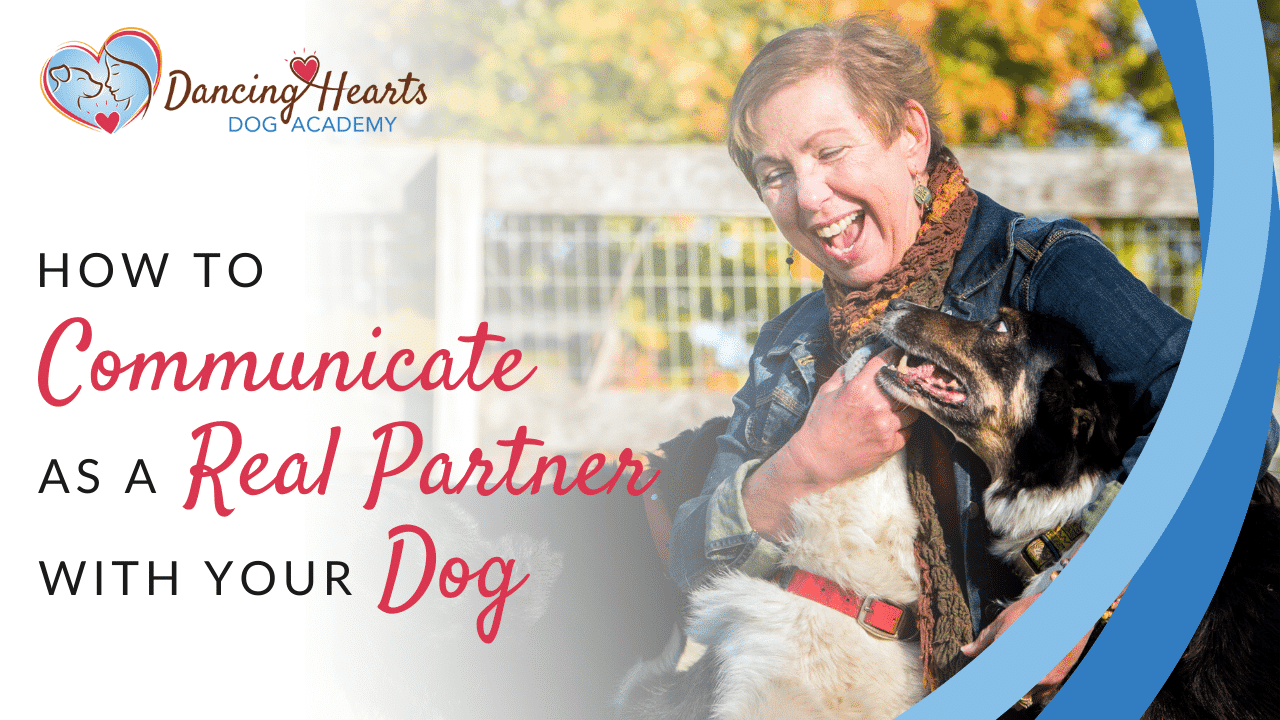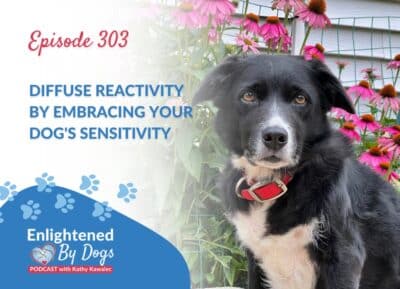What’s the key to any successful partnership or relationship?
That’s right. It’s all about communication!
Communication is what ties your partnership with your dog together, so you’re both happy and healthy.
This is part two of my ongoing blog and podcast series, “The Summer Series on The Power of Partnership.” In this series, I’m sharing some simple partnership principles that you can easily incorporate in your day-to-day lives with your dog.
Each episode will follow Mary, an avatar client and dog mom, who’s facing some challenges with her dog, Max. As I share each principle, we’ll look at how Mary uses these lessons to build a solid partnership with Max.
It’s a glimpse at what working together as a partner really looks like. If you haven’t already read the first blog or listened to the episode, I’d recommend starting there.
Ready? Let’s talk about communication…
Dogs are masters of reading our intentions
The second partnership principle I want to talk about is that communication leads to partnership.
Good communication is an essential element of a good partnership between you and your dog.
The key is establishing a language for easy dialogue and connection, so you can get to know and trust each other.
I’ve said it before, but there’s really no way to fool a dog. Dogs are masters of reading our intentions. Your dog is so tuned in to what you’re doing and even what you’re about to do.
Mastering this type of communication with your dog requires you to be more focused, attentive, and clear.
I promise the payoff for this is extraordinary. Once my clients have got the communication side down, they end up with happy, eager dogs who are willing to cooperate.
That’s because, like humans, dogs are social creatures and are naturally masterful at dialogue and reading communication through body language. This is something humans can do as well, but we’re often so distracted that we aren’t even aware of it!
Have you ever thought, “my dog reacted so unexpectedly!” Or you’ve been shocked when your dog started barking or growling at something? Those are signs that you are distracted at times when instead, you want to be available for connection and support.
If you’ve ever had the thought, “my dog just won’t listen,” or that they’re stubborn or just don’t understand – those are signs that you’re not communicating clearly at a time when dialogue is crucial.
This all leaves your dog scratching their ear, feeling pretty confused.
The art of mindful dialoguing
The good news is that you can discover the fine art of intentional communication and establish a daily practice of mindful dialoguing.
You can learn to be more conscious of things like using your body, your posture, the direction of your gaze, the tension or relaxation of your muscles, your breathing pattern, and much more. Your dog notices all these things and reacts accordingly.
They can also hear exceptionally well, so it helps to verbalize softly and use sound modulation to communicate.
Your use of movement, expression, breathing, and your personal space (by stepping toward your dog or backing away), are effective non-verbal communication tools. These movements and body language all have an effect on how your dog responds to you, whether intentionally or not.
So the key is to become more intentional and aware of yourself. Try to be a student and allow your dog to teach you. I encourage you to take some time to observe their responses to your dialogue and day-to-day interactions. You can learn so much from this.
“Be a student and allow your dogs to teach you by observing their responses to your dialogue and your interactions with them.”
Balance being an observer with being a partner
While we need to observe, we still need to be good partners as well.
It’s really important to balance this adventure in dialogue discovery with being a great partner. If you’re in scientist/observation mode, you’re not also being a partner, so try to bear that in mind. Balance is everything.
How Mary’s progressing
Let’s talk about Mary and Max. In part one, we saw that Mary was starting to implement the partnership principles she’s learned.
She’s been practicing patience and focusing on connection and clarity. This is helping both Mary and Max to be calmer and more attentive.
Mary has also been feeling and expressing love and appreciation for Max. She has stopped going for walks that would lead to Max pulling and getting over-aroused and frustrated. Instead, she’s focused on finding other interesting things to do together.
After two weeks, Mary feels that she and Max have established a new, stronger appreciation for each other.
How to get a dog back into balance
Now that Mary and Max are more attentive to one another, and Max has learned self-regulation, they’re ready to walk together as partners.
It’s all about baby steps, though. Mary takes it slow and ensures that their mutual attentiveness keeps getting stronger.
What Mary needed to work on was learning how to stay connected through the leash. Mary learned that our dogs can sometimes get “out of balance” physically, mentally, and emotionally when they pull on the leash. So, instead of thinking, “my dog is pulling,” she says, “my dog is out of balance.”
When this happens, helping a dog get back into balance is always the first step. You can do this in a few ways. Mary learned that balance could look like an equal weight on all four of their paws to start with. Soft and quick pulsing of the leash also helps to bring a dog back into balance.
You can even use the leash around the chest or the ribs to encourage balance and a more complete connection.
Remember, body language and voice are the primary tools for walking with your dog. The leash is secondary, so never use the leash to initiate movement. Don’t pull your dog. When we pull our dog, we set an expectation and teach them that pulling each other is okay.
Mary learned that by not pulling, she’s role modeling. She learned instead to always invite your dog to move with you, using body language and voice.
How to get started
Mary decided to start in a place with few distractions to learn this new way of walking together. She started in her kitchen, then the family room, then the backyard. All these places became opportunities for learning.
Mary learned to always be sure that Max was attentive and in balance before she asked him to walk with her. She realized that it all starts with her. For Max to be relaxed and happy, Mary needed to be first.
Her next step was to look at where she was intending to walk before signaling to Max to follow. If Max began to lean forward out of balance, Mary felt it immediately. She helped Max to regain his balance whenever that happened.
Now, if Max loses his focus and pulls, Mary moves forward but tries not to pull him back. She asks him to reconnect with her by pulsing or vibrating the leash to promote balance and connection. And, when necessary, she signals “stop” to Max and pivots in front of him to help him rebalance. Once Max had refocused, Mary simply pivots back to facing forward with Max by her side.
This simple maneuver really helped Mary to stay calm and connected with Max. Now, they enjoy walking together so much more.
“Mastering this part of the partnership lifestyle formula requires that we learn to be focused, attentive, and clear as we interact with our dogs.”
How can you start communicating better with your dog?
Now it’s your turn. Take from this lesson the best ways to communicate and implement that into your life with your dog.
I’ll share some journal prompts below which might help you get clear on what you need to do:
- Where can you more clearly communicate with your dog in a way that they can understand?
- Where can you closely listen to your dog’s feedback about this challenge that you are having together?
- How can you modify the way that you and your dog dialogue that will help you to work together to resolve this challenge?
- Can you identify the specific body language, facial expression, or verbal expression that you and your dog are using when there’s a communication breakdown?
- When has there been communication success?
- How do you believe your dog is interpreting your intention?
- Do you believe that you may have misinterpreted your dog’s intention?
- When are you and your dog attentive to one another? When are you not?
I encourage you to take a few of these prompts and really dive into what your partnership means and looks like right now. Have some fun with it! And I hope to see you next time for part three.
If you’d like to work with me and learn how to create a partnership lifestyle for you and your dog, you can request an invitation to join us in the Brilliant Partners Academy when the doors open for the next enrollment!
You can listen to everything I talked about in this blog post over on my podcast – Enlightened By Dogs. It’s episode 168, which you can listen to here.







One Response
I find your talks very instructive. I have the same problem as Mary, my dogs don’t pull all the time, but get frantic when they see another dog. Can I train both at the same time or would it be easier to take out one at a time